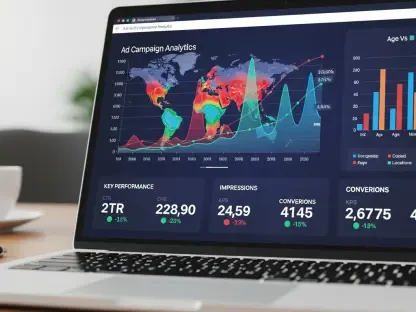Why Social Media is a Game-Changer for Real Estate in 2025
In an era where digital presence dictates business success, social media stands as a pivotal force for real estate professionals aiming to capture attention and drive growth. Recent data from the National Association of Realtors (NAR) reveals that over 70% of homebuyers begin their search online, with a significant portion influenced by content seen on platforms like Instagram and LinkedIn. This statistic underscores a transformative shift, positioning social media not just as a tool for visibility but as a primary avenue for building trust and generating leads in the real estate sector.
Beyond mere numbers, the impact of these platforms is evident in real-world outcomes. Consider the case of a Texas-based realtor who doubled their referral rate within six months by consistently sharing market insights and property tours on TikTok, engaging a younger demographic of first-time buyers. Such examples highlight how a strategic online presence can translate into tangible business results, from stronger client relationships to increased activity on listings, making mastery of social media an indispensable skill for agents today.
The evolving digital landscape further amplifies this necessity, highlighting the importance of staying current with technological trends. As algorithms prioritize authentic, engaging content, real estate professionals who adapt to these changes can position themselves ahead of competitors still relying on traditional marketing methods. This dynamic environment offers an opportunity to not only showcase properties but also to craft a personal brand that resonates with potential clients, setting the stage for long-term success in a crowded market.
The Growing Importance of Social Media in Real Estate
Historically, real estate marketing leaned heavily on physical signage, print ads, and word-of-mouth referrals, but the rise of social media has redefined how agents connect with clients. According to NAR reports, social platforms have surpassed brokerage websites and listing portals as the leading source of quality leads for real estate professionals. This shift reflects a broader trend where digital interactions increasingly shape consumer behavior, making an online presence non-negotiable for those in the industry.
The advantages of embracing these platforms extend across multiple dimensions, breaking down geographic barriers and allowing agents to reach out-of-state buyers or international investors with the same ease as local clients. Additionally, features like hashtags and location tags enhance listing visibility, ensuring properties are seen by targeted audiences, while consistent engagement builds trust and showcases market expertise, positioning agents as go-to resources in their communities.
Moreover, social media fosters collaboration opportunities with other professionals involved in property transactions, such as staging experts, mortgage brokers, and photographers. These connections not only enrich an agent’s network but also provide clients with comprehensive services, further solidifying credibility. As a tool for lead generation and client accessibility, social media’s role continues to expand, offering a direct line to potential buyers and sellers who are already active on these platforms, ready to engage at the click of a button.
Step-by-Step Strategies to Dominate Real Estate Social Media in 2025
Navigating the competitive landscape of real estate requires a well-thought-out approach to social media that prioritizes actionable tactics over random posting. The following steps provide a roadmap for agents to enhance their digital footprint, attract quality leads, and convert online interactions into real-world deals. Each strategy is designed to be practical, with specific tips and examples to ensure effective implementation.
Step 1: Craft a Tailored Social Media Strategy
Creating a personalized social media plan is the foundation of any successful online marketing effort in real estate, as it helps agents stand out in a competitive field. This involves understanding the specific market dynamics, identifying ideal client profiles, and focusing on property types that align with an agent’s expertise. A strategic approach ensures that every post serves a purpose, whether it’s building brand awareness or driving inquiries, even if initial engagement appears slow. Over time, this consistency compounds, creating a lasting impression on potential clients.
Focus on Your Unique Value
Differentiation in a saturated market hinges on showcasing what sets an agent apart, whether it’s a deep knowledge of luxury condos, a knack for finding fixer-uppers, or a commitment to first-time buyers. Highlighting these unique strengths in content—through posts about successful deals or client testimonials—helps establish a distinct identity. Such focus not only attracts the right audience but also builds a reputation as a specialist in specific niches.
Start Small and Scale
For those new to social media marketing, the prospect of managing multiple platforms can be daunting, especially when you’re unsure where to start or how to maintain consistency across different channels. Begin with achievable goals, such as posting twice a week on a single platform, and focus on quality over quantity. As familiarity and confidence grow, expand to additional channels or increase posting frequency. This gradual approach prevents burnout and allows for adjustments based on what resonates most with followers, ensuring sustainable growth.
Step 2: Pick the Right Platforms for Your Audience
Not every social media platform suits every real estate professional’s goals, making it critical to focus efforts where target clients are most active. For instance, LinkedIn might be ideal for connecting with high-net-worth individuals in the luxury market, while Instagram and TikTok often appeal to younger, first-time homebuyers. Selecting the right platforms maximizes engagement and ensures resources are not wasted on channels with little return.
Research Your Demographic
Understanding client demographics is key to platform selection, as it helps in identifying the right online spaces for engagement. Analyze factors like age, income level, and interests to determine where potential buyers and sellers spend their time online. Tools like platform analytics or surveys can provide insights into user behavior, guiding decisions on whether to prioritize visually driven platforms like Instagram or professional networks like LinkedIn. This targeted research ensures content reaches the most relevant audience.
Test and Adapt
Experimentation is vital in identifying the most effective platforms for engagement, so start by posting similar content across a few selected channels and monitor metrics such as likes, shares, and direct messages to gauge response. Based on these results, refine the approach by doubling down on high-performing platforms and scaling back on others. This iterative process ensures adaptability to changing trends and audience preferences, optimizing lead quality over time.
Step 3: Leverage Short-Form Video for Maximum Impact
Short-form video content, such as Instagram Reels and TikTok clips, has become a dominant force in capturing audience attention due to its digestibility and algorithmic favor. For real estate agents, these formats offer a dynamic way to showcase properties and expertise, keeping viewers engaged in a fast-scrolling digital world. Prioritizing video content can significantly boost visibility and interaction rates.
Create Engaging Content Ideas
Developing captivating video content starts with variety, ensuring a broad appeal that can draw in diverse viewers with different interests. Property tours that highlight unique features, quick market update snippets, or participation in trending challenges can hook viewers instantly. For example, a “guess the price” video of a listing can keep audiences watching until the end, increasing engagement. These formats not only entertain but also position the agent as a knowledgeable and approachable figure in the industry.
Keep It Authentic
Authenticity in video content fosters trust with potential clients. Rather than overly polished productions, focus on genuine interactions that reflect personality and expertise. A simple walkthrough of a home narrated with personal insights or a candid discussion of market trends can resonate more than a scripted advertisement. This realness helps build connections, encouraging viewers to see the agent as a relatable partner in their home-buying journey.
Step 4: Use Social Listening to Understand Client Needs
Social listening, the practice of monitoring online conversations, offers invaluable insights into client needs, preferences, and concerns. For real estate professionals, this means uncovering pain points—such as fears about affordability or confusion over market trends—and addressing them through tailored content. This proactive approach demonstrates attentiveness and builds credibility with an audience seeking guidance.
Tools for Social Listening
Several tools can streamline the process of social listening. Platforms like Hootsuite provide features to track mentions, hashtags, and keywords related to real estate, helping agents stay informed about trending topics. Additionally, native analytics on platforms like Twitter can reveal sentiment and frequently discussed issues. Utilizing these resources ensures a comprehensive understanding of what drives client decisions in the current market.
Address Pain Points
Once common concerns are identified through listening, content should be crafted to directly tackle these issues. For instance, if followers frequently express anxiety over rising interest rates, a series of posts or videos explaining mortgage options or market forecasts can provide clarity. This targeted content not only positions the agent as a problem-solver but also fosters trust, encouraging potential clients to reach out for personalized assistance.
Step 5: Boost Reach with Targeted Paid Ads
Paid social media advertising offers a powerful way to amplify content reach beyond organic followers, ensuring listings and services are seen by a precisely defined audience. With the ability to target based on demographics, location, and interests, these ads can connect with qualified leads who might otherwise miss an agent’s posts. Strategic investment in paid campaigns can yield significant returns in visibility and inquiries.
Set Precise Targeting Parameters
Effective ad campaigns begin with detailed targeting. Define parameters such as geographic location to focus on specific neighborhoods or cities, age ranges to appeal to first-time buyers or retirees, and interests like home improvement or investment properties. This precision ensures that ads reach individuals most likely to engage, whether they are browsing for a family home or seeking rental opportunities, maximizing the impact of every dollar spent.
Track Ad Performance
Monitoring the success of paid ads is crucial for optimization, and tools like Hootsuite Ads allow for comprehensive tracking of campaign metrics to help achieve this goal. These metrics include click-through rates and conversions, providing valuable insights into what resonates with the audience. Regularly reviewing these reports enables adjustments to targeting or creative elements, ensuring a better return on investment and refining future advertising efforts for even greater effectiveness.
Step 6: Build Relationships Through Engagement
While posting content is essential, engagement through comments, direct messages, and interactions transforms followers into potential clients. Active participation in conversations shows responsiveness and care, turning casual interactions into opportunities for building community and trust. This relational aspect of social media often proves more impactful than sheer reach in driving business outcomes.
Prioritize Direct Conversations
Timely responses to messages and comments are critical in fostering trust. Whether answering a question about a listing or acknowledging feedback on a post, prompt and thoughtful replies demonstrate a commitment to client needs. These direct conversations can often lead to deeper discussions about buying or selling, paving the way for conversions that might not occur through passive content alone.
Use Tools to Stay Organized
Managing engagement across multiple platforms can be challenging, but tools like Hootsuite Inbox simplify the process by consolidating messages and comments into a single dashboard. This ensures no interaction is overlooked, allowing agents to stay organized and maintain consistent communication, reinforcing their reliability and professionalism in the eyes of potential clients seeking a dependable partner.
Step 7: Showcase Local Expertise and Stories
Demonstrating deep knowledge of local markets and sharing unique property narratives can set an agent apart as a trusted resource. Content that highlights neighborhood quirks, historical context, or community events not only educates but also emotionally connects with potential buyers. This approach transforms listings from mere transactions into compelling stories that resonate on a personal level.
Share Neighborhood Insights
Posting about local events, popular hangouts, or new developments in the area adds value to an agent’s content. For instance, a video showcasing a neighborhood festival or a post about a trending restaurant opening can make followers feel more connected to the community. Such insights position the agent as an insider, someone who understands the lifestyle and appeal of the areas they represent.
Craft Compelling Narratives
Storytelling elevates listings beyond basic descriptions by highlighting a property’s unique history, such as a home built out of spite or one tied to a local legend, which can capture attention and make the listing memorable. These narratives, shared through engaging posts or videos, spark curiosity and encourage shares, expanding reach while illustrating the agent’s creativity in marketing properties.
Step 8: Maintain Consistency in Posting
Regular posting is a cornerstone of social media success, keeping agents top of mind with their audience. A consistent schedule trains followers to anticipate content, increasing the likelihood of engagement even if algorithms shift. This reliability in presence mirrors the dependability clients seek in a real estate professional, reinforcing brand strength over time.
Develop a Content Calendar
Planning content in advance using a calendar ensures a steady flow of posts and helps maintain consistency in your online presence. Schedule around key events like open houses, seasonal market updates, or personal milestones to keep your content relevant. This structured approach prevents last-minute scrambles and allows for thoughtful content creation that aligns with both business goals and audience interests, enhancing overall impact.
Balance Content Types
A well-rounded feed includes a mix of promotional, educational, and personal posts to ensure a diverse and engaging online presence. Share listing highlights alongside market tips or behind-the-scenes glimpses of daily work to keep content varied and interesting. This balance prevents follower fatigue from overly sales-focused material and builds a more authentic connection, encouraging sustained interaction with the agent’s online presence.
Key Takeaways for Real Estate Social Media Success
- Build a personal brand before focusing on listings to establish trust and recognition among potential clients.
- Utilize short-form video content to stay relevant and engaging, capturing attention in fast-paced feeds.
- Emphasize relationships over mere reach by prioritizing meaningful engagement through comments and messages.
- Develop a strategic plan that targets the right platforms and audience for efficient use of resources.
- Leverage paid ads and social listening to enhance visibility and gain deeper client insights.
- Post consistently with a blend of local expertise and authentic content to maintain audience interest and trust.
Future Trends and Challenges in Real Estate Social Media Marketing
Looking ahead, the role of artificial intelligence in content creation and analytics is set to grow, offering tools for personalized posts and predictive insights into client behavior from 2025 onward. This technological advancement promises efficiency but also raises the bar for competition as more agents adopt sophisticated strategies. Staying ahead will require continuous learning to harness these innovations effectively without losing the human touch that defines real estate interactions.
Increased platform saturation presents another challenge, as more professionals vie for attention on popular channels. Differentiating through hyper-personalized content—tailored to specific client segments or local nuances—will be critical to stand out. Additionally, frequent algorithm changes can disrupt visibility, necessitating flexibility in tactics and a focus on evergreen engagement practices that prioritize direct communication over fleeting trends.
Maintaining authenticity amidst automation remains a significant hurdle in today’s digital world, where technology often overshadows personal touch. While AI can streamline posting schedules, over-reliance risks diluting the personal connection that clients value. Balancing technological aids with genuine storytelling and interaction will be key. Adapting to these shifts while centering relationships ensures resilience, preparing agents to navigate an ever-evolving digital landscape with confidence and impact.
Final Thoughts: Take Action to Thrive in 2025
Reflecting on the journey of mastering social media for real estate, the steps taken—from crafting tailored strategies to embracing consistent engagement—have laid a robust foundation for generating leads and establishing brand authority. Each effort invested in understanding platforms, leveraging video, and building relationships has contributed to a stronger digital presence that translates into tangible business growth.
Looking back, the commitment to starting small with manageable goals proved wise, allowing for gradual scaling while honing skills in content creation and audience interaction. Tools like Hootsuite and Canva emerged as invaluable allies, simplifying complex tasks and enhancing output quality. Their role in organizing interactions and designing compelling visuals underscored the importance of leveraging technology to stay competitive.
As a next step, consider accessing specialized resources to further refine these efforts and enhance your social media presence in the real estate industry. Exploring a free social media strategy template designed for real estate professionals can provide a structured starting point, while trialing tools with free periods offers hands-on experience without immediate commitment. These actions pave the way for continued improvement, ensuring that the momentum built through strategic social media use carries forward into even greater achievements.









